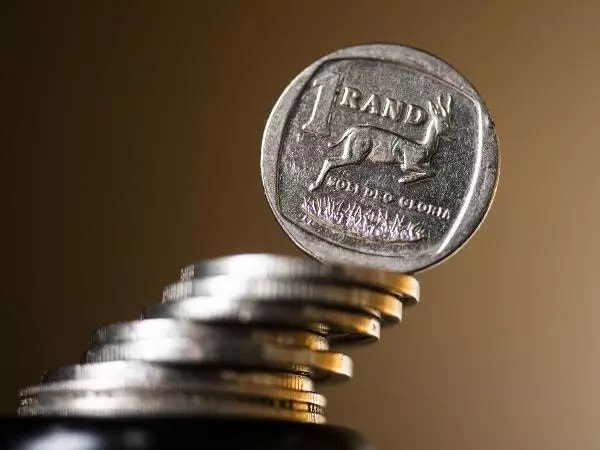10 most volatile forex pairs to trade

What is volatility in forex?
Before we delve into the rankings, let's first understand how volatility is measured. Volatility is a measure of how much price tends to move in a given financial market. In this article, we will be using the average 30-day realized volatility over the last 3 years to measure volatility. This provides us with a historical perspective on the currency pairs' price movements.
More on the best times to trade forex
Therefore, it is crucial to find a balance between liquidity and volatility to identify potential trading opportunities. For this list, we will be analyzing US dollar pairs as it is the world’s most traded currency and most liquid.
The 10 most volatile forex pairs (USD)
1. USD/ZAR - Volatility: 12.9%
The South African rand has been highly volatile in recent years, with an average volatility of nearly 13% over the last three years. It has also experienced significant price swings, losing more than 20% against the US dollar with a high-to-low range of almost 50%
2. AUD/USD - Volatility: 9.6%
The Australian dollar has also been volatile, losing 12% over the last three years. It has traded between historical lows near 0.6000 and highs close to 0.8000. While commonly viewed as a commodity currency due to Australia’s gold production, recently AUD has moved in correlation with stocks and China’s economy.
3. NZD/USD - Volatility: 9.5%
The New Zealand dollar, closely tied to the Australian economy, has exhibited similar volatility to the AUD, with an average volatility of 9.5% over the last three years.
4. USD/MXN - Volatility: 9.2%
US dollar has seen significant volatility against the Mexican peso, appreciating by 13% over the last few years. It has traded between highs of 22.000 and lows below 17.000, making it an attractive pair for traders seeking volatility.
5. GBP/USD - Volatility: 7.7%
British Pound has relatively lower volatility compared to the previous pairs, with an average volatility of 7.7% against the US dollar over the last three years. It has experienced a significant drop but has had a relatively small range of 25% from 1.4000 to 1.0500.
6. USD/JPY - Volatility: 7.6%
Despite losing more than 40% of its value against the US dollar, Japanese yen has exhibited lower volatility, slightly higher than 7%. This is because the currency pair has risen to historical extremes over the years but does not see significant short-term percentage moves.
7. USD/CHF - Volatility: 6.7%
Swiss franc has been about unchanged vs USD the last three years, but USD/CHF did make it up to parity before falling 1000 pips below 0.9000. This low volatility may be advantageous to some traders as the pair has been viewed as a safe-haven currency in recent years.
8. EUR/USD - Volatility: 6.6%
The euro has seen lower volatility in recent years, with an average of 6.6% against the US dollar. EUR/USD has lost around 10% of its value and even hit parity in 2022 but has not experienced large short-term price movements throughout.
9. USD/CAD - Volatility: 6.1%
Canadian dollar has not been as volatile against USD due to the close ties between the US and Canadian economies. However, the commodity currency can experience volatility when influenced by crude oil prices, as Canada is a major exporter of oil.
10. USD/SGD - Volatility: 3.9%
USD/SGD is the least volatile currency pair among the top 10, with an average of under 4% over the last few years. This minor pair has traded within a relatively narrow range, making it less attractive for swing traders looking for quick price action.
Monitoring forex markets
It is important to note that volatility can change over time. These rankings are based on recent years' data, and volatility can vary widely in the long term. Foreign exchange markets and exchange rates are affected by numerous factors including interest rates and geopolitical events. Traders should regularly monitor volatility levels and adjust their trading strategies accordingly.
Traders may also choose to trade non-USD pairs such as AUD/JPY, NZD/JPY and CAD/JPY that can experience higher volatility than major currency pairs, though often risking lower liquidity. Analyzing standard deviations as well as trading volume are essential to understand the liquidity-volatility balance, especially in exotic currency pairs.
Learn more about advanced indicators
The forex currency pairs discussed in this article can offer various trading opportunities, depending on individual risk tolerance and trading strategies. However, it is essential to practice risk management and use appropriate tools such as stop-loss orders to mitigate potential losses. Always remember that forex trading involves a level of risk, and it is important to conduct thorough research before engaging in any trading activities.
How to trade forex volatility
- Open an account to get started, or practice on a demo account
- Choose your forex trading platform
- Monitor pairs using volatility measures
- Open and close positions on forex pairs
Trading forex requires an account with a forex provider like tastyfx. Many traders watch major forex pairs like EUR/USD and USD/JPY, which can be found in tastyfx's platform under the 'Major' pairs tab, for potential opportunities based on economic events such as inflation releases or interest rate decisions. Economic events can produce more volatility for forex pairs, which can mean greater potential profits and losses as risks can increase at these times.
You can help develop your forex trading strategies using resources like tastyfx’s YouTube channel. Our curated playlists can help you stay up to date on current markets and understanding key terms. Once your strategy is developed, you can follow the above steps to opening an account and getting started trading forex.
Your profit or loss is calculated according to your full position size. Leverage will magnify both your profits and losses. It’s important to manage your risks carefully as losses can exceed your deposit. Ensure you understand the risks and benefits associated with trading leveraged products before you start trading with them. Trade using money you’re comfortable losing.
Which currency has the highest volatility?
Among US dollar pairs, the South African Rand (ZAR) has the highest volatility. USD/ZAR has a volatility of 12.9% over the past 3 years.
This information has been prepared by tastyfx, a trading name of tastyfx LLC. This material does not contain a record of our trading prices, or an offer of, or solicitation for, a transaction in any financial instrument. You should not treat any opinion expressed in this material as a specific inducement to make any investment or follow any strategy, but only as an expression of opinion. This material does not consider your investment objectives, financial situation or needs and is not intended as recommendations appropriate for you. No representation or warranty is given as to the accuracy or completeness of the above information. tastyfx accepts no responsibility for any use that may be made of these comments and for any consequences that result. See our Summary Conflicts Policy, available on our website.

